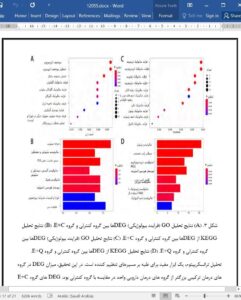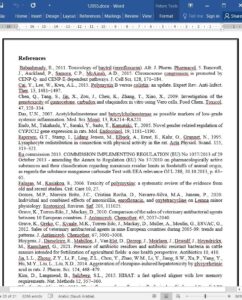Abstract
Presently, toxicological assessment of multiple veterinary antimicrobials has not been performed on mammals. In this study, we assessed the short-term toxicity of enrofloxacin (E) combined with colistin (C) and quinocetone (Q). Young male rats were orally dosed drug mixtures and single drugs in 14 consecutive days, each at the dose of 20, 80, and 400 mg/(kg·BW) for environmental toxicologic study. The results showed that at the high dose treatment, the combination of E + C+Q significantly decreased body intake, lymphocytes count on rats; significantly increased the values of Alanine aminotransferase (ALT), Glutamic oxaloacetic transaminase (AST) and, cholinesterase (CHE); it also got the severest histopathological changes, where sinusoidal congestion and a large number of black particles in sinusoids were observed. This means E + C+Q in the high dose groups was able to cause significant damage to the liver. Other combinations or doses did not induce significant liver damage. Transcriptome analysis was then performed on rats in high dose group for further research. For E + C and E + Q, an amount of 375 and 480 differently expressed genes were filtered out, revealing their possible underlying effect on genomes. For E + C+Q, a weighted gene co-expression network analysis was performed and 96 hub genes were identified to reveal the specific effect induced by this combination. This study indicates that joint toxicity should be taken into consideration when involving the risk assessment of these antimicrobials.
1. Introduction
Recently, the risk of multiple chemicals, especially manmade chemicals, has become to public’s awareness and concern (McEntaggart et al., 2019). Served as a large category of chemicals, veterinary antimicrobials are widely used for disease treatment, disease prevention, and growth promotion of animals (Grave et al., 2010, 2012; Van Boeckel et al., 2015). As a result, severe residues of antimicrobial mixtures may occur to animals. Some reports revealed that multiple veterinary drug contamination has also been existed in water, food and soil (Brown et al., 2020; Han et al., 2020). Thus, the assessment of the joint toxicity for veterinary drugs is of significance for ecological environment concerns and human health.
5. Conclusion
A 14-day short-term toxicity study showed that E + C+Q treatment induced severe hepatoxicity at the dose of 400 mg/(kg⋅BW) per drug. However, no obvious hepatoxicity impact was observed in combination E + C, E + Q, and single drugs. Transcriptome study revealed that E + C treatment had the potential to interfere with cell cycle, E + Q treatment disrupted the metabolic pathways. E + C+Q treatment interfered with both metabolic functions and immune functions. This study would enrich references for the risk assessment of antimicrobial mixtures.











